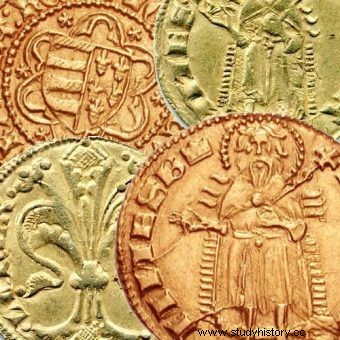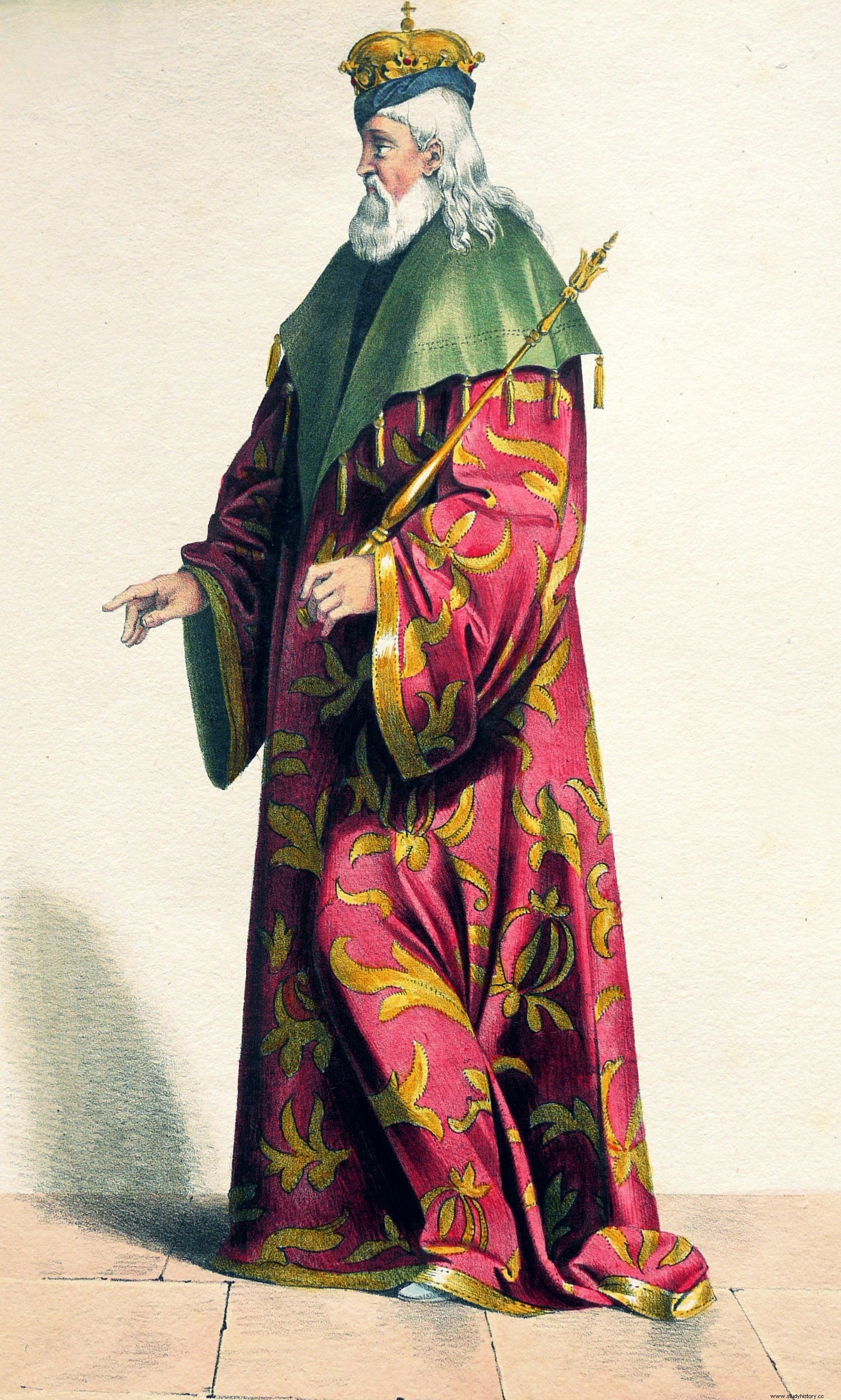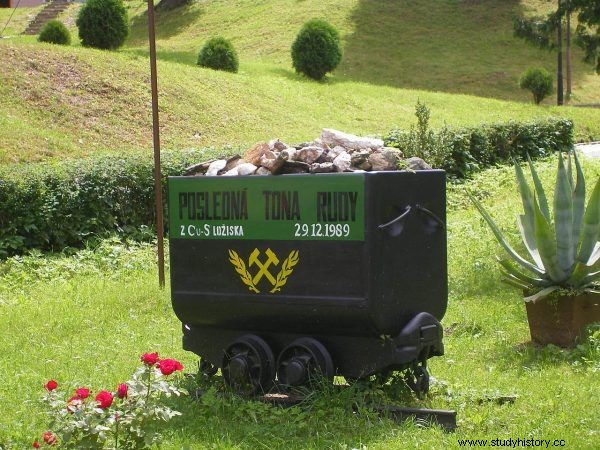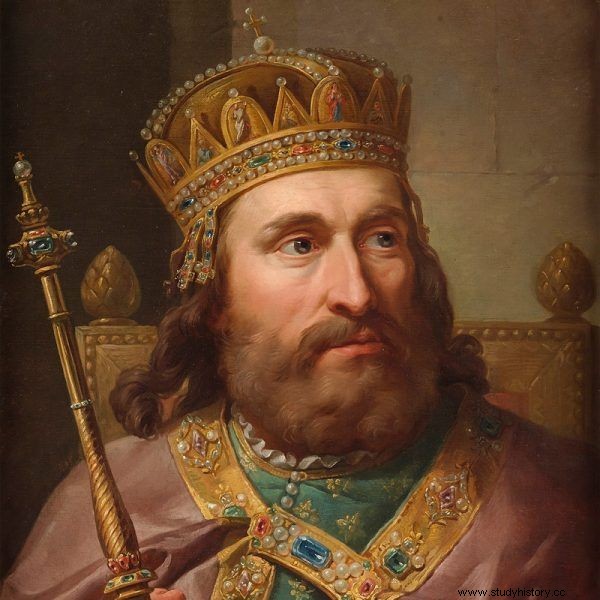In the late Middle Ages, one country met up to 80% of European gold demand. A country co-ruled by a Polish woman. And which unexpectedly became an undisputed superpower.
At the turn of the thirteenth and fourteenth centuries, Hungary was a poor country, torn apart by internal conflicts, and even deprived of its own dynasty, after the royal Arpad family died out. The ruthless civil war between the new monarch from Naples, Charles Robert, and a group of powerful oligarchs dragged on for years, leaving fortresses in ruins and cities in ruins.

Gold of Hungary. Florens from the 14th and 15th centuries.
Even the end of the fighting did not give hope that Hungary would return to the rank of an important player on the international arena. They were rightly treated as a backward and ruined backwater.
The Forgotten Empire
This was still the case in 1320. Meanwhile, ten years later, the kingdom of Saint Stephen not only dealt cards in the immediate vicinity, but even became one of the most powerful powers in all of Europe. Not only did Charles Robert consolidate his power in the state by eliminating all opposition and confiscating hundreds of private castles, but he also began to seriously think about seizing his patrimony - the Southern Italian Kingdom of Naples.

Karol Robert at the end of his life. Early 19th century lithograph.
As if that were not enough, the monarch built a magnificent palace in Visegrád, considered one of the most magnificent mansions in Europe, organized stunning knightly tournaments, always ate from pure gold tableware, and lived - together with the entire mansion of hundreds of people - in an indescribable luxury.
His son, Ludwik Węgierski he went many steps further. Every year he waged wars with almost all of his neighbors. He made two trips to Italy, conquered Dalmatia, constantly fought in the Balkans, helped Poland, ruled by Casimir the Great , to take over Red Ruthenia ... He was a great patron of culture, and some historians even call him the medieval absolute ruler, an example of which could be taken from the French "king of the Sun", who lived several hundred years later.
The Hungarians remembered the second king of the Anjou dynasty as Louis the Great for a reason. But where was the secret of this monarch's extraordinary successes?
His character and chivalrous upbringing were also important. The influence of the queen mother, who came from Poland Elżbieta Łokietkówna , cannot be underestimated either which invariably shook Hungarian politics and was respected by both the imperial and papal court . But it wasn't the personal details that turned out to be the most important. As usual:if you don't know what's going on, it's gotta be money.
A discovery that cannot be overestimated
Soon after 1320, huge and easily accessible gold deposits were located in Hungary. Karol Robert perfectly understood the importance of this discovery. He immediately started organizing the mining, issued far-reaching privileges, and even brought in experienced miners from neighboring Bohemia.
Already in 1325, the monarch issued a document authorizing the opening of the mine in Aranyosbánya (today's Baia de Arieș in Romania). According to the diploma, analyzed by the Hungarian historian Boglárka Weisz, the mining settlement was excluded from the jurisdiction of any court except the royal one, and Charles Robert handed over to its citizens an area extending one and a half miles from the planned mine shaft. In return, miners were required to transfer one-eighth of all income to the ruler and submit to the measurements of the quality and quantity of the ore carried out by the court's - as we would put it today - auditor.

In Smolnik, mining was carried out until 1989. The photo shows the last wagon with the spoil.
Similar privileges were also in force in other mining centers, such as Nagybánya (Baia Mare in today's Romania) or Szomolnokbánya (Smolník in today's Slovakia). Although the share of the court in the profits may seem small, it should be remembered that the king did not incur any costs related to the construction of the mine, and still collected taxes, which in time began to bring him tons of gold.
Moreover, gold, at prices set by the court and, of course, favorable to the king, always ended up in the hands of the ruler. Only he had the right to put them into circulation.
European Eldorado
The most important mine was located in Körmöcbánya, i.e. Kremnica in what is now Slovakia. This settlement was granted privileges in 1328 and quickly became a key source of Hungarian wealth. As Pal Engel, one of the most prominent Hungarian medievalists emphasized, Kremnica's activities "left a deep mark on the economy of the whole of Europe".
Swimming in wealth, Charles Robert became the first ruler north of the Alps to mint his own gold coins. The oldest ones come from 1326. They were modeled on the money issued in Florence and known as "florins". Hungarian coins had the same name. It was not until the following centuries that the name evolved so that the "florins" became "forints".
Each coin weighed 3.5 grams and was almost perfect - 23.75 carats. How many exactly were they killed? It's impossible to say, but the overall scale of the extraction was downright staggering.
"According to estimates one third of the gold produced in the world at that time came from Hungary and two thirds from Africa "- explains Paul Lendvai in the synthesis of Hungarian history A thousand years of victories in defeats . - "While African gold remained almost entirely in the Muslim Orient, European demand was 80% covered by Hungarian supplies ”.

Portrait of Ludwik Węgierski by Marcello Bacciarelli.
The annual output of Hungarian mines during the reign of Charles Robert and Ludwik Węgierski is carefully estimated at up to one and a half tons of gold. It is possible that it was ... even bigger. When the Queen Mother, Elżbieta Łokietkówna in 1343 set off on a journey to Italy, she took with her, a trifle, almost seven tons of pure silver and five tons of gold.
Other kings needed long years of meticulous tax-shaking of their subjects to collect a similar sum. For Elizabeth, meanwhile, who ruled with her son perhaps the richest kingdom on the continent, it was merely a handy fund for unforeseen expenses. Oh, needed during pocket travels…
Selected bibliography:
The article was based on materials collected by the author during the work on the book "Ladies of the Polish Empire. The Women Who Built a Power " . Some of these items are shown below. Full bibliography in the book.
- Dąbrowski J., Elżbieta Łokietkówna 1305-1380 , Universitas, Krakow 2007.
- Dąbrowski J., The last years of Ludwik the Great 1370-1382 , Universitas, Krakow 2009.
- Engel P., The Realm of St. Stephen. A History of Medieval Hungary 895-1526 , I.B. Tauris, London-New York 2001.
- Lendvai P., Hungarians. A thousand years of victories in defeats , International Cultural Center, Krakow 2016.
- Sroka S.A., Anjou's reorganization of Hungary , "Kwartalnik Historyczny", vol. 103, issue 2 (1996).
- Sroka S.A., Pilgrimage of Queen Elizabeth the Short to Rome in 1343 , "Peregrinus Cracoviensis", issue 4 (1996).
- Weisz B., Mining Town Privileges in Angevin Hungary , "Hungarian Historical Review," vol. 2 (2013).
